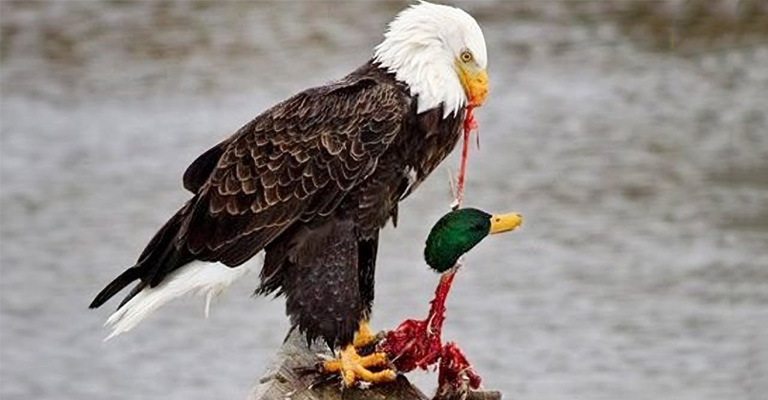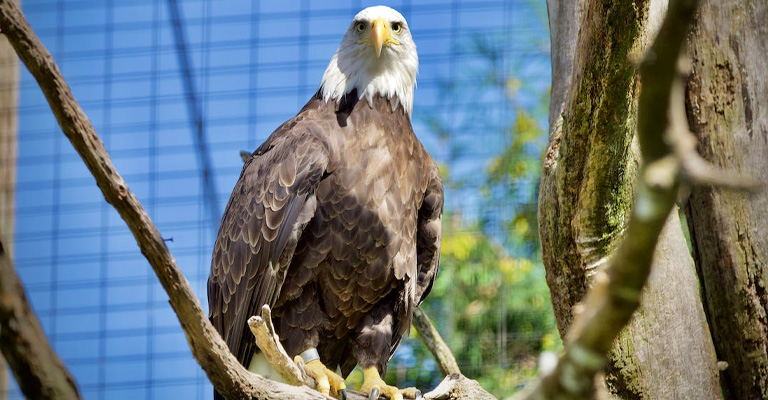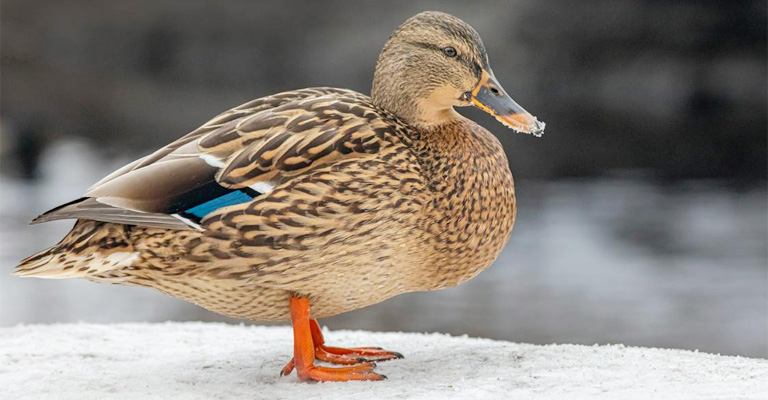The majestic bald eagle, a symbol of freedom and power, is an apex predator of the avian world. With its sharp talons and piercing gaze, this raptor is known for its impressive hunting skills.
But what about its dining preferences? Do bald eagles eat ducks? In this article, we’ll delve into the intriguing relationship between bald eagles and ducks.
Bald eagles are opportunistic hunters, known to feed on a variety of prey, and ducks are certainly on the menu. From the skies to the water’s surface, these eagles employ remarkable strategies to catch their feathered prey.
We’ll explore their hunting techniques, preferred duck species, and the role of these interactions in the ecosystem.
Whether you’re a bird enthusiast or simply curious about the bald eagle’s dietary habits, join us as we uncover the fascinating world of these majestic birds and their appetite for ducks.

Do Bald Eagles Eat Ducks?
Bald eagles (Haliaeetus leucocephalus) are native to North America and are renowned for their keen eyesight, strong talons, and majestic appearance. They predominantly inhabit coastal and inland waters, which offer an abundance of food sources.
They are opportunistic predators, meaning they are not confined to a single type of prey. Instead, they adapt their hunting strategies to the available food supply.
Aerial Ambush: A Spectacular Hunting Technique
One of the most awe-inspiring sights in the natural world is the bald eagle’s aerial hunting prowess. These birds can dive at astonishing speeds to snatch fish from the water’s surface. However, this remarkable skill is not limited to piscivorous habits alone.
Bald eagles often employ this aerial ambush strategy when hunting ducks. They spot their prey from great heights and, with precision, descend to grasp the unsuspecting duck with their powerful talons.
This method is not only a testament to the eagle’s hunting prowess but also an essential survival strategy.
Ducks: A Dietary Delight for Bald Eagles
While bald eagles have a broad diet, ducks are certainly one of their favored culinary choices. Ducks are abundant in various water bodies across North America, making them accessible and nutritious prey for these apex predators.
Mallards, teal, and mergansers are some of the duck species commonly hunted by bald eagles.
Bald eagles do not discriminate much in terms of duck species. Their hunting choices are often influenced by what’s available in their particular region. Mallards are frequent targets due to their wide distribution and the bald eagle’s ability to adapt to various hunting situations.
Ecological Significance

The bald eagle’s preference for ducks holds ecological significance. These eagles, as top-tier predators, play a vital role in maintaining the balance of ecosystems. By preying on ducks, they help control duck populations, preventing overpopulation and its associated environmental consequences.
Furthermore, their hunting activities influence the behavior of ducks. Ducks become more vigilant and wary, which can have a cascading effect on their feeding and nesting habits, ultimately contributing to the health of wetland ecosystems.
The Circle of Life: Nesting and Rearing Chicks
Bald eagles are renowned for their impressive nests, which can be found high in trees near water bodies. The availability of ducks in their diet extends to their nests, as they often use duck feathers as nest lining material.
Interestingly, bald eagles may opportunistically capture and feed ducks to their chicks during the breeding season. This provides essential nutrition to the growing eaglets and further underscores the interplay between bald eagles and ducks in their shared environments.
Conservation and Bald Eagles
Understanding the dietary habits of bald eagles is not only fascinating for ornithologists but also essential for wildlife conservation. Bald eagles, once listed as an endangered species, have made a remarkable recovery thanks to conservation efforts.
Recognizing the role of ducks in their diet helps conservationists make informed decisions about habitat protection and management.
How Do You Protect Ducks from Eagles?

Ducks, with their vibrant plumage and diverse species, are a beloved and vital component of wetland ecosystems across North America. However, they are not without their share of natural predators, and one of the most formidable is the bald eagle.
Protecting ducks from eagles is a multifaceted challenge, requiring an understanding of both species and their roles in the ecosystem. In this article, we will explore various strategies and considerations for safeguarding ducks from these raptors.
Understanding the Dynamics
Before delving into protection strategies, it’s essential to comprehend the natural dynamics between ducks and eagles. Bald eagles are opportunistic hunters, and ducks are a part of their varied diet.
Ducks, on the other hand, are equipped with instincts and behaviors developed through evolution to evade predators. This natural interplay between predator and prey has shaped both species over millennia.
Habitat Preservation
One of the most effective ways to protect ducks from eagles is through habitat preservation. Wetlands, marshes, and other water bodies are the primary habitats for ducks.
By preserving these ecosystems, we ensure that ducks have suitable breeding and feeding grounds. Healthy, undisturbed wetlands offer ducks cover and foraging opportunities that reduce their vulnerability to eagles.
Vegetation and Cover
Ducks rely on the cover of vegetation to hide from predators, including eagles. Planting and maintaining appropriate vegetation around water bodies can help create safe spaces for ducks.
These vegetative buffers not only offer protection but also contribute to the overall health of the wetland ecosystem.
Artificial Nest Platforms
In some cases, the installation of artificial nest platforms can provide ducks with safer nesting sites. These platforms are designed to be inaccessible to ground-based predators and may deter eagles as well.
Ducks can use these platforms to raise their young with reduced exposure to aerial threats.
Scaring Devices
Scaring devices are another strategy to protect ducks from eagles. These devices are designed to deter eagles from approaching areas with vulnerable duck populations.
Visual deterrents like scarecrows or reflective objects, combined with auditory deterrents such as noise-making devices, can create an environment that is less attractive to eagles.
Hunting Regulations
In some areas, regulated hunting of bald eagles can be a method of control. However, this is highly controversial and heavily regulated due to the bald eagle’s protected status in the United States.
Any consideration of this strategy must be approached with caution and in compliance with relevant wildlife laws and regulations.
Aversion Conditioning
Aversion conditioning is a method of teaching ducks to be wary of eagles. It involves controlled exposure of ducks to simulated or actual eagle threats, which encourages them to become more vigilant and responsive to potential dangers.
While this technique can be effective, it must be done with care to avoid causing undue stress to the duck population.
Predator Management
Managing the overall population of eagles in an area can be an effective long-term strategy for protecting ducks. However, this approach typically involves a careful balance of predator management with respect for the eagles’ protected status.
It often requires the collaboration of wildlife agencies and conservation organizations.
Collaboration and Education
Conservation efforts to protect ducks from eagles often benefit from collaboration among various stakeholders, including conservation organizations, government agencies, and local communities.
Education and outreach programs can inform the public about the importance of wetland ecosystems and the need to protect both ducks and eagles. These efforts can garner support for conservation initiatives.
Balancing Act: Protecting Ducks and Eagles
It’s crucial to recognize that while protecting ducks from eagles is a valid concern, it should not come at the expense of the eagles.
Bald eagles, once listed as an endangered species, have made a remarkable recovery, in part due to conservation efforts. Striking a balance between the needs of these two species and the broader ecosystem is essential.
Furthermore, preserving the natural dynamics of predator-prey relationships is a fundamental aspect of ecosystem health. Both ducks and eagles play vital roles in their respective niches, and their interactions are integral to the overall balance of wetland ecosystems.
Protecting ducks from eagles is a multifaceted challenge that requires a nuanced approach. By focusing on habitat preservation, vegetation, and cover, as well as the use of deterrents and regulated hunting where appropriate, we can help safeguard duck populations.
FAQs
Are all species of ducks equally vulnerable to eagle predation?
No, not all duck species are equally vulnerable to eagle predation. The susceptibility of a duck species to eagle attacks depends on factors like the duck’s size, behavior, and the specific hunting strategies of the eagles in a given region.
Do ducks ever fight back against eagle attacks?
Ducks will sometimes attempt to evade or fight back against eagle attacks. Their natural instincts and behaviors include taking evasive actions, flying away, or vocalizing to alert nearby ducks of the impending danger.
Are eagles the primary threat to duck populations?
Eagles are one of several natural predators that ducks face. Other threats to duck populations include foxes, raccoons, and various aquatic predators. Additionally, human activities, habitat destruction, and pollution can pose significant threats to duck populations.
Do ducks always successfully protect their nests from eagle attacks?
Ducks have evolved a range of defensive behaviors to protect their nests, but the outcome of these encounters with eagles can vary. Some duck species are more successful in defending their nests than others.
What role do ducks play in the ecosystem, and how does the predation by eagles affect it?
Ducks are important components of wetland ecosystems. They help control aquatic insect populations, disperse seeds, and contribute to nutrient cycling. Predation by eagles on ducks can help regulate duck populations, preventing overpopulation and its ecological consequences.
Conclusion
Bald eagles are versatile predators with a taste for ducks among various other prey. Their powerful talons and keen eyesight make them formidable hunters in both terrestrial and aquatic environments.
This preference for ducks not only showcases their adaptability but also highlights the intricate balance of nature’s food chain.
Understanding the dietary habits of bald eagles is not only an exciting aspect of ornithology but also crucial for wildlife conservation. As these majestic birds continue to share their habitat with other species, their role as top predators influences the dynamics of ecosystems.
While we’ve explored the question, “Do bald eagles eat ducks?” the answer is clear: yes, they do.
This insight into the feeding habits of one of North America’s most iconic raptors offers a deeper appreciation for the interconnectedness of the natural world and the role each species plays in maintaining its delicate equilibrium.